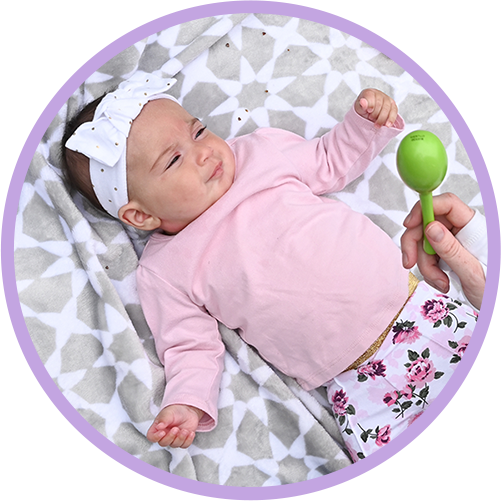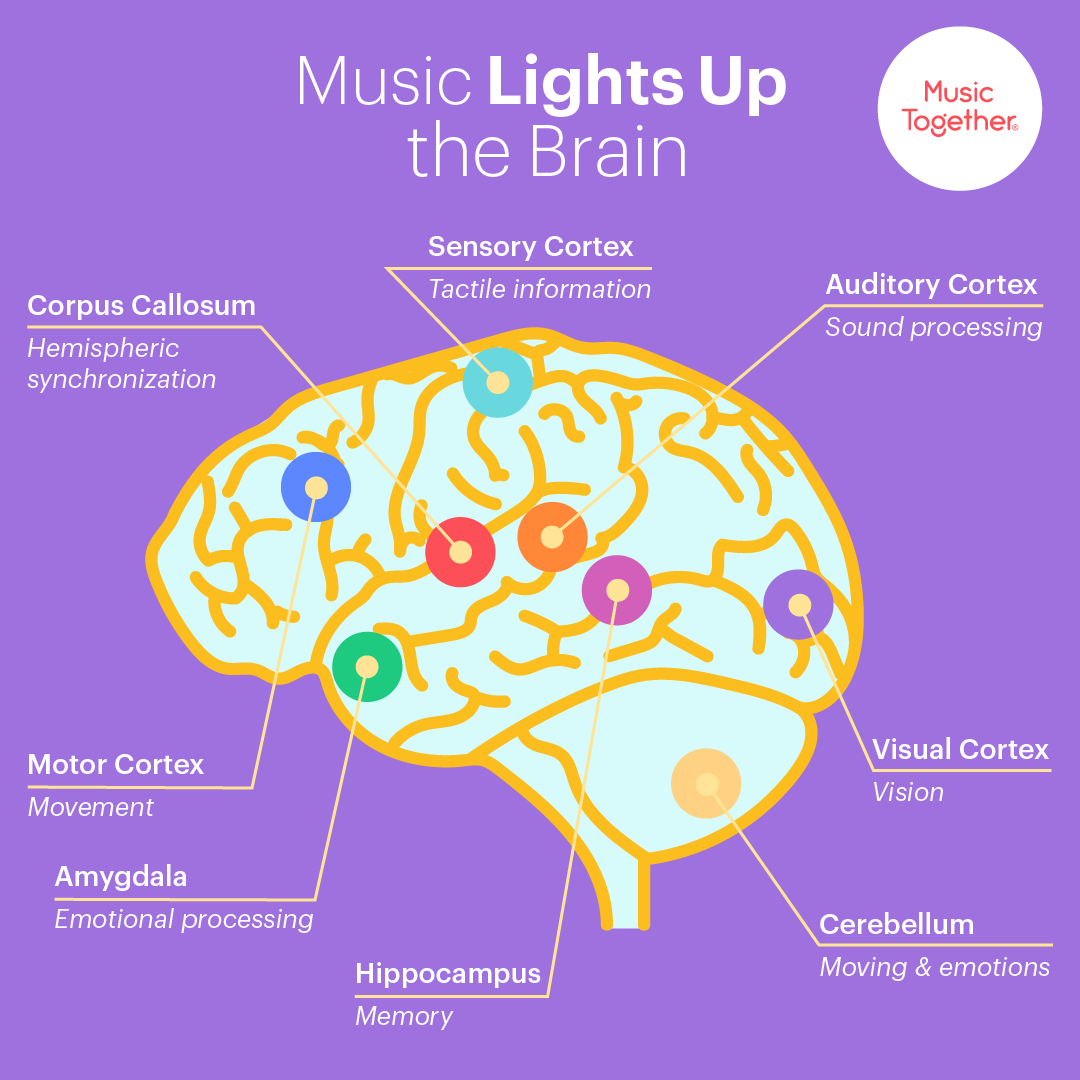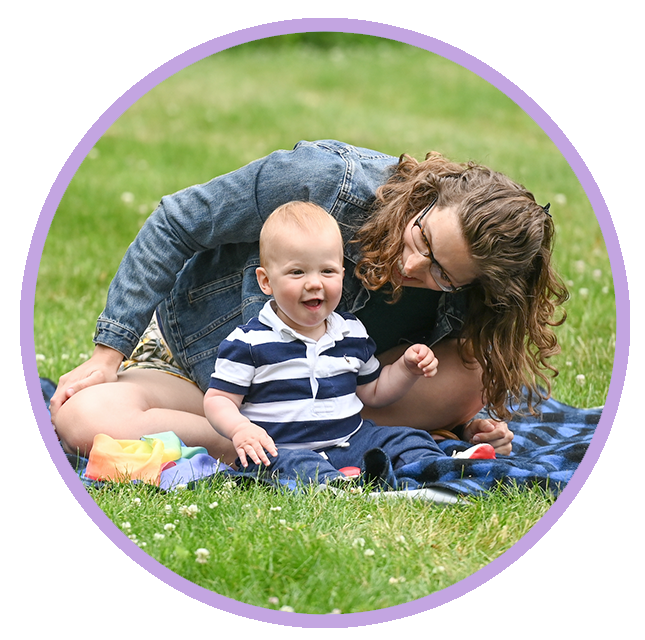
Babies can be puzzling. They are little, they are squishy, and they seem to need help doing everything. And yet we know that huge development is happening on the inside, as their brains grow at an astronomical rate. If you’ve ever asked yourself, “What’s going on in there?” you’re not alone. We can help with some insight into what babies’ brains are up to when you make music with them.
Music Processing in Babies’ Brains
When you sing, bounce, dance, and play with music, in class or at home, at least eight areas of baby’s brain are activated at the same time. Here’s a peek into what happens in babies’ brains during music experiences:

- Auditory cortex: Hearing you sing, baby’s brain processes incoming sound waves.
- Visual cortex: Watching you move, baby’s brain processes incoming light waves.
- Sensory cortex: Feeling the action of dancing or playing with instruments, baby’s brain processes tactile feedback.
- Motor cortex: As your baby moves their arms, legs, tongues, etc. during music, this activates baby’s motor cortex.
- Amygdala: Your baby’s emotional response to music lights up the amygdala.
- Cerebellum: Your infant’s cerebellum lights up during movement.
- Hippocampus: Music enhances the brain’s ability to store memories.
- Corpus callosum: Music activates the corpus callosum, which connects and synchronizes the two sides of the brain.
Music Experiences in the First Year Shape the Brain for Lifelong Learning
During the first three years of life, our brains grow at an extraordinary rate: With every new experience, brain cells link to others, and babies’ brains form about 700 new connections per second just in the first year. Experiences determine which of these neural connections are “saved” for life, shaping brains for future learning. Because music-making activates so much of the brain during this time of incredible plasticity, music experiences uniquely support growth across multiple domains. Here are some examples of how music shapes development, along with activities to try with your little ones.
Music Shapes Biology
During music experiences involving face-to-face singing and activities like tapping babies to the music, important chemicals can be released in the brain, commonly resulting in decreased heart rate, blood pressure, and stress hormones—as well as enhanced muscular coordination and tone and regulation of the digestive, respiratory, and circulatory systems.
Music Shapes Neurology
The visual, auditory, and kinesthetic input inherent in music experiences also stimulates neural connections. Sensory input taken in through the eyes and ears stimulates the sensory cortex, visual cortex, auditory cortex, cerebellum, and more.
Music Shapes Language Development
Brain imaging has shown that singing engages areas of the brain essential to the input/processing and output/production of language.
Music Shapes Emotional Connection and Self-regulation
Dancing, playing, and singing with babies strengthens the infant-caregiver attachment relationship through the release of hormones such as oxytocin, dopamine, and serotonin. Singing with babies has also been shown to optimize cortisol levels, both during and after these musical moments. (High levels of this stress hormone have been found to harm the brain during this early period of development.)
Over time, and with a lot of repetition, songs become a part of children’s long-term memory and serve as tools for understanding the world and integrating life experiences. With each song you sing, you are giving your baby the early, repeated music experiences that build their brains—and fill their souls.
Making Music Is Good for You, Too!

As parents of babies, so much of your focus is on them, but you need caretaking, too! When you make music with your baby, you can look forward to some pretty good fringe benefits: Singing and dancing lowers our stress levels and connects us to one another, which is good for the whole family.
It’s common to think of music as something we listen to on our headphones, or as “piano lessons” or “choir practice.” However, in reality “music” is much, much more. Music is emotion, connection, ritual, and complexity. It’s something we turn to again and again to mark important life transitions, to help us cope with loss and celebrate love, and to gather in shared purpose and community. Music is a uniquely human way of knowing and understanding the world around us, of learning who we are and how to be—and it starts when we’re very young.
So the next time you pick up your baby and dance around the kitchen, or sing a song while changing their diaper, you can know that big things are happening. Inside that wonderful, squishy body is a brain that’s sparking and changing with every note you sing and every move you make.
References
Center on the Developing Child at Harvard University (2011). Building the brain’s “air traffic control” system: How early experiences shape the development of executive function: Working Paper No. 11. Retrieved from http://www.developingchild.harvard.edu.
Field, T. (2010). Touch for socioemotional and physical well-being: A review. Developmental Review, 30, 367-383.
Flohr, J. W. & Persellin, D. C. (2011). Applying brain research to children’s musical experiences. In, S. L. Burton & C. C. Taggart (Eds.), Learning from Young Children: Research in Early Childhood Music. MD: Lanham
Fox, S. E., Levitt, P. & Nelson, C. A. (2010). How the timing and quality of early experiences influence the development of brain architecture. Child Development, 81(1), 28-40.
National Scientific Council on the Developing Child. (2004). Children’s emotional development is built into the architecture of their brains: Working Paper No. 2. Retrieved from http://www.developingchild.harvard.edu.
National Scientific Council on the Developing Child. (2010). Early experiences can alter gene expression and affect long-term development: Working paper no. 10. Retrieved from http://www.developingchild.harvard.edu.
Tierney, A.L. & Nelson, C.A. (2009). Brain development and the role of experience in the early years. Zero to Three, 30(2), 9-13.
The Urban Child Institute. (n.d.). Baby’s brain begins now: Conception to age 3. Retrieved from http://www.urbanchildinstitute.org/why-0-3/baby-and-brain.
Trollinger, V.L. (2010). The Brain in Singing and Language. General Music Today, 23(3), 20-23.
Schore, J. R. & Schore A. N. (2008). Modern attachment theory: The central role of affect regulation in development and treatment. Clinical Social Work Journal, 36(1), 9-20



